第10章 练习答案财务管理
财务管理课后答案清华大学出版社
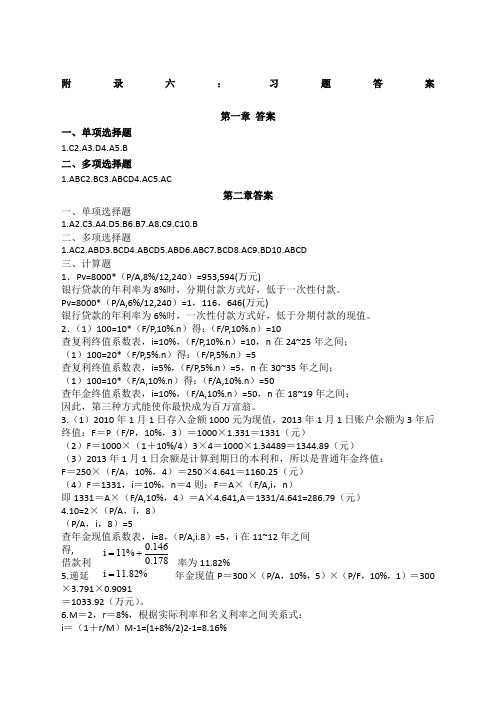
附录六:习题答案第一章 答案一、单项选择题 1.C2.A3.D4.A5.B 二、多项选择题 1.ABC2.BC3.ABCD4.AC5.AC第二章答案一、单项选择题1.A2.C3.A4.D5.B6.B7.A8.C9.C10.B 二、多项选择题1.AC2.ABD3.BCD4.ABCD5.ABD6.ABC7.BCD8.AC9.BD10.ABCD 三、计算题1.Pv=8000*(P/A,8%/12,240)=953,594(万元)银行贷款的年利率为8%时,分期付款方式好,低于一次性付款。
Pv=8000*(P/A,6%/12,240)=1,116,646(万元)银行贷款的年利率为6%时,一次性付款方式好,低于分期付款的现值。
2.(1)100=10*(F/P,10%.n )得:(F/P,10%.n )=10 查复利终值系数表,i=10%,(F/P ,10%.n )=10,n 在24~25年之间; (1)100=20*(F/P,5%.n )得:(F/P,5%.n )=5 查复利终值系数表,i=5%,(F/P,5%.n )=5,n 在30~35年之间; (1)100=10*(F/A,10%.n )得:(F/A,10%.n )=50 查年金终值系数表,i=10%,(F/A,10%.n )=50,n 在18~19年之间; 因此,第三种方式能使你最快成为百万富翁。
3.(1)2010年1月1日存入金额1000元为现值,2013年1月1日账户余额为3年后终值:F =P (F/P ,10%,3)=1000×1.331=1331(元)(2)F =1000×(1+10%/4)3×4=1000×1.34489=1344.89(元)(3)2013年1月1日余额是计算到期日的本利和,所以是普通年金终值: F =250×(F/A ,10%,4)=250×4.641=1160.25(元) (4)F =1331,i =10%,n =4则:F =A ×(F/A,i ,n )即1331=A ×(F/A,10%,4)=A ×4.641,A =1331/4.641=286.79(元) 4.10=2×(P/A ,i ,8) (P/A ,i ,8)=5查年金现值系数表,i=8,(P/A,i.8)=5,i 在11~12年之间得, 借款利率为11.82% 5.递延年金现值P =300×(P/A ,10%,5)×(P/F ,10%,1)=300×3.791×0.9091 =1033.92(万元)。
财务管理学课后习题答案
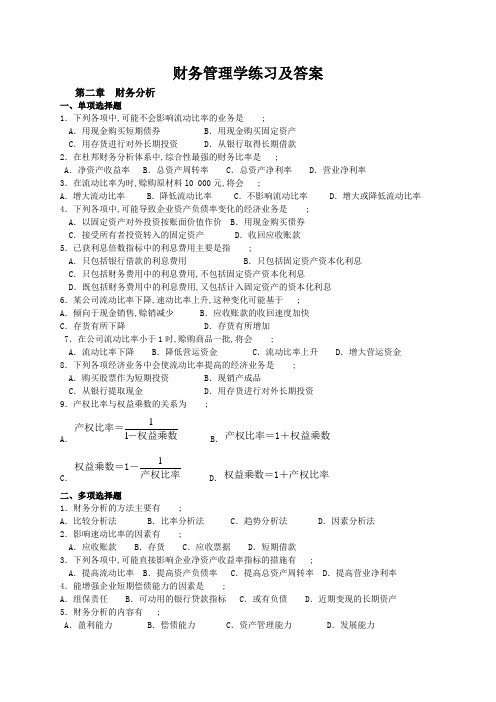
财务管理学练习及答案第二章财务分析一、单项选择题1.下列各项中,可能不会影响流动比率的业务是 ;A.用现金购买短期债券 B.用现金购买固定资产C.用存货进行对外长期投资 D.从银行取得长期借款2.在杜邦财务分析体系中,综合性最强的财务比率是 ;A.净资产收益率 B.总资产周转率 C.总资产净利率 D.营业净利率3.在流动比率为时,赊购原材料l0 000元,将会 ;A.增大流动比率 B.降低流动比率 C.不影响流动比率 D.增大或降低流动比率4.下列各项中,可能导致企业资产负债率变化的经济业务是 ;A.以固定资产对外投资按账面价值作价 B.用现金购买债券C.接受所有者投资转入的固定资产 D.收回应收账款5.已获利息倍数指标中的利息费用主要是指 ;A.只包括银行借款的利息费用 B.只包括固定资产资本化利息C.只包括财务费用中的利息费用,不包括固定资产资本化利息D.既包括财务费用中的利息费用,又包括计入固定资产的资本化利息6.某公司流动比率下降,速动比率上升,这种变化可能基于 ;A.倾向于现金销售,赊销减少 B.应收账款的收回速度加快C.存货有所下降 D.存货有所增加7.在公司流动比率小于1时,赊购商品一批,将会 ;A.流动比率下降 B.降低营运资金 C.流动比率上升 D.增大营运资金8.下列各项经济业务中会使流动比率提高的经济业务是 ;A.购买股票作为短期投资 B.现销产成品C.从银行提取现金 D.用存货进行对外长期投资9.产权比率与权益乘数的关系为 ;A.11产权比率=-权益乘数 B.产权比率=1+权益乘数C.1权益乘数=1-产权比率 D.权益乘数=1+产权比率二、多项选择题1.财务分析的方法主要有 ;A.比较分析法 B.比率分析法 C.趋势分析法 D.因素分析法2.影响速动比率的因素有 ;A.应收账款 B.存货 C.应收票据 D.短期借款3.下列各项中,可能直接影响企业净资产收益率指标的措施有 ;A.提高流动比率 B.提高资产负债率 C.提高总资产周转率 D.提高营业净利率4.能增强企业短期偿债能力的因素是 ;A.组保责任 B.可动用的银行贷款指标 C.或有负债 D.近期变现的长期资产5.财务分析的内容有 ;A.盈利能力 B.偿债能力 C.资产管理能力 D.发展能力6.在其他条件不变的情况下,会引起总资产周转率指标上升的经济业务是 ;A.用现金偿还负债 B.用银行存款购入一台设备C.借入一笔短期借款 D.用银行存款支付一年的报刊订阅费7.某公司当年的经营利润很多,却不能偿还到期债务;应检查的财务比率包括 ;A.资产负债率 B.流动比率 C.速动比率 D.应收账款周转率8.影响总资产净利率的因素有 ;A.资产平均总额 B.利息支出 C.净利润 D.权益乘数9.若公司流动比率过高,可能由情况所导致;A.产品滞销 B.应收账款增多 C.待摊费用增加 D.待处理财产损失增加l0.沃尔评分法的缺点有 ;A.选定的指标缺乏证明力 B.不能对企业的信用水平做出评价C.不能确定总体指标的累计分数D.指标严重异常时,对总评分产生不合逻辑的影响三、判断题1.因素分析法中各因素替代顺序是:先质量后数量;先实物量后货币量;先主要后次要;先基础后派生;2.当资金收益率高于债务利息率时,债务比例的增加对投资者是有利的;3.趋势分析法只能用于同一企业不同时期财务状况的纵向比较,而不能用于不同企业之间的横向比较;4.权益乘数的高低取决于企业的资金结构:资产负债率越高,权益乘数越高,财务风险越大; 5.产权比率侧重于揭示财务结构的稳健程度以及自有资金对偿债风险的承受能力;6.或有负债可能增强企业的偿债能力;7.在进行已获利息倍数对指标的同行业比较分析时,从稳健的角度出发,应以本企业该指标最高的年度数据作为分析依据;8.权益净利率是评价企业自有资本及其积累获取报酬水平的最具综合性与代表性的指标,其适用范围广,但受行业局限;9.某公司今年与上年相比,主营业务收入净额增长10%,净利润增长8%,资产总额增加12%,负债总额增加9%;可以判断,该公司净资产收益率比上年下降了;10.市盈率是评价上市公司盈利能力的指标,它反映投资者愿意对公司每股净利润支付的价格;一、单项选择题:1. A 2. A 3. B 4. C 5. D 6. C 7. C 8. B 9. D二、多项选择题:1. ABCD 2. ACD 3. BCD 4. BD 5. ABCD 6. AD 7. BCD 8. AC9. ABCD l0. AD三、判断题:1.× 2.√ 3.× 4.√ 5.√ 6.× 7.×8.× 9.√ 10.√第三章财务管理的基本观念一、单项选择题1.货币的时间价值是一种的结果;A.自然增值B.使用权转移C.投资和再投资D.所有权转移2.预付年金现值系数与普通年金现值系数的不同之处在于 ;A.期数要减1B.系数要加1C.期数要减1,系数要加1D. 期数要加1,系数要减13.在期望值相同的情况下,标准离差越大的方案其风险 ;A.越大B.越小C.二者无关D.无法判断4.财务风险是带来的风险;A.通货膨胀B.高利率C.筹资决策D.销售决策5.风险报酬是指投资者因冒风险进行投资而获得的 ;A.利润B.额外报酬C.利息D.利益6.标准离差是各种可能的报酬率偏离的综合差异;A.期望报酬率B.概率C.风险报酬率D.实际报酬率7.投资项目的风险报酬率取决于全体投资者对风险的态度;若投资者都愿冒风险投资,则风险报酬率就 ;A.大B.等于零C.小D.不确定二、多项选择题1.影响货币时间价值大小的因素主要包括 ;A.单利B.复利C.资金额D.利率E.期限2.下列各项中,属于普通年金形式的项目有 ;A.零存整取储蓄存款的整取额B.定期定额支付的养老金C.年资本回收额D.偿债基金E.支付优先股的股利3.下列表述中,正确的有 ;A.复利终值系数和复利现值系数互为倒数B.普通年金终值系数和普通年金现值系数互为倒数C.普通年金终值系数和偿债基金系数互为倒数D.普通年金现值系数和投资回收系数互为倒数E.预付年金现值系数和预付年金终值系数互为倒数4.在财务管理中,经常用来衡量风险大小的指标有 ;A.标准离差B.边际成本C.风险报酬率D.贡献毛益E.标准离差率5.从单个公司本身来看,风险分为 ;A.市场风险B.财务风险C.经营风险D.外汇风险E.交易风险三、判断题1.一般说来,资金时间价值是指没有通货膨胀条件下的投资报酬率;2.递延年金终值的大小与递延期无关,故计算方法和普通年金终值是一样的;3.名义利率指一年内多次复利时给出的年利率,它等于每期利率与年内复利次数的乘积;4.对于多个投资方案而言,无论各方案的期望值是否相同,标准离差率最大的方案一定是风险最大的方案;5.国库券是一种几乎没有风险的有价证券;其利率可以代表资金时间价值;6.根据风险于收益对等原理,高风险的投资项目必然会获得高收益;一、单项选择题:二、多项选择题:三、判断题:1.× 2.√ 3.√ 4.√ 5.× 6.×第四章证券估值一、单项选择题:1. 购买平价发行的每年付息一次的债券,其到期收益率和票面利率 ;A.前者大于后者 B.后者大于前者 C.无关系 D.相等2. 以下投资项目中,风险最大的是 ;A.国库券 B.银行存款 C.股票 D.公司债券3. 债券期限越长,其利率风险 ;A.越小 B.越大 C.为零 D.无法确定二、多项选择题:1.长期债券收益率高于短期债券收益率,这是因为 ;A.长期债券持有时间长,难以避免通货膨胀影响 B.长期债券流动性差C.长期债券面值高 D.长期债券不记名2.债券投资人的实际利息收入取决于 ;A.债券面值 B.票面利率 C.债券持有期 D.计息方式及债券到期日3.股票未来现金流入的现值,被称为股票的 ;A.市值 B.面值 C.内在价值 D.理论价值三、判断题:1.到期收益率反映的是债券投资人按复利计算的真实收益率;若高于投资人要求的投资收益率,则应买进债券;2.进行债券收益水平评价时,可不考虑资金时间价值;3.利率固定的有价证券没有利率风险;4.证券市场上所有投资项目,其风险都与预期报酬率成正比;5.固定利率债券比浮动利率债券承担更大的利率风险;一、单项选择题:二、多项选择题:三、判断题:1.√ 2.× 3.× 4.√ 5.√第五章财务预测与财务预算一、单项选择题:1. 企业的外部融资需求的正确估计为 ;A.资产增加-预计总负债-预计股东权益B.资产增加-负债自然增加-留存收益的增加C.预计总资产-负债自然增加-留存收益的增加D.预计总资产-负债自然增加-预计股东权益增加2.与生产预算没有直接联系的预算是;A.直接材料预算B.变动制造费用预算C.销售及管理费用预算D.直接人工预算3.企业的全面预算体系以作为终结;A.销售预算 B.现金预算 C.预计财务报表 D.资本支出预算4. 属于编制全面预算的出发点的是 ;A.销售预算 B.生产预算 C.现金预算 D.预计利润表5.下列各项中,不能直接在现金预算中得到反映的是 ;A.期初现金余额 B.现金筹措情况 C.现金收支情况 D.产销量情况6.下列各项中,没有直接在现金预算中得到反映的是 ;A.期初期末现金余额B.现金筹措及运用C.预算期产量和销量D.预算期现金余缺二、多项选择题:1.企业若打算减少外部融资的数量,应该 ;A.提高销售利润率 B.提高股利支付率 C.降低股利支付率 D.提高销售量2.编制预计财务报表的编制基础包括 ;A.生产预算 B.销售预算 C.资本支出预算 D.制造费用预算3.编制生产预算中的“预计生产量”项目时,需要考虑的因素有 ;A.预计销售量 B.预计期初存货 C.预计期末存货 D.前期实际销量 E.生产需用量4.产品成本预算,是预算的汇总;A.生产 B.直接材料 C.直接人工 D.制造费用5.下列各项中,被纳入现金预算的有 ;A.税金的缴纳 B.现金盈余或不足 C.现金收入 D.股利和利息支出6.与生产预算有直接联系的预算是 ;A.直接材料预算B.变动制造费用预算C.销售及管理费用预算D.直接人工预算三、判断题:1.制造费用预算分为变动制造费用和固定制造费用两部分;变动制造费用和固定制造费用均以生产预算为基础来编制;2. “现金预算”中的“所得税现金支出”项目,要与“预计利润表”中的“所得税”项目的金额一致;它是根据预算的“利润总额”和预计所得税率计算出来的,一般不必考虑纳税调整事项;3.管理费用多属于固定成本,所以,管理费用预算一般是以过去的实际开支为基础,按预算期的可预见变化来调整;4.生产预算是规定预算期内有关产品生产数量、产值和品种结构的一种预算;5.制造费用预算是根据生产预算为基础来编制的;6.生产预算是只以实物量作为计量单位的预算;一、单项选择题:二、多项选择题:三、判断题:1.╳ 2. ╳ 3. √ 4. ╳ 5. ╳ 6. √第六章投资管理一、单项选择题:1.投资项目使用企业原有的非货币资产,其相关的现金流量应为非货币资产的A.帐面价值 B.变现价值 C.折余价值 D.原始价值2. 计算投资方案的增量现金流量时,需考虑的成本是 ;A.沉没成本 B.历史成本 C.重置成本 D.帐面成本3. 如果考虑货币的时间价值,固定资产年平均成本是未来使用年限内现金流出总现值与的比值;A.年金现值系数 B.年金终值系数 C.回收系数 D.偿债系数4. 下列项目不引起现金流出的是 ;A.支付材料款 B.支付工资 C.垫支流动资金 D.计提折旧5. 在进行项目风险分析时,易夸大远期现金流量风险的方法是 ;A.净现值法 B.内含报酬率法 C.风险调整贴现率法 D.肯定当量系数法二、多项选择题:1.投资方案评价指标中,考虑了时间价值因素的有 ;A.会计收益率 B.回收期 C.净现值 D.内部报酬率 E.现值指数2.某一投资方案的净现值大于零,则意味着该方案 ;A.贴现后现金流入大于现金流出 B.贴现后现金流入小于现金流出C.报酬率大于预定的贴现率 D.报酬率小于预定的贴现率3.关于投资项目营业现金流量预计,以下做法正确的有 ;A.营业现金流量等于税后净利加折旧B.营业现金流量等于营业收入减去付现成本再减去所得税C.营业现金流量等于税后收入减去税后成本再加上折旧引起的税负减少额D.营业现金流量等于税后收入减去税后成本再加上折旧三、判断题:1.对于投资方案来说,只有增量现金流才是相关现金流量;2.一个企业能否维持下去,不取决于是否有足够的现金满足各种支付,而关键是看其是否盈利;3.投资项目评价所用的内部报酬率指标,其指标的计算与项目预定的贴现率高低有直接关系;4.肯定当量系数是指不肯定的1元现金流量期望值相当于使投资者满意的肯定金额的系数;5.设备更新决策中,若新旧设备未来使用年限不同,则不宜采用净现值法和内部报酬率法;一、单项选择题:二、多项选择题:三、判断题:1.√ 2.× 3.× 4.√ 5.√第七章流动资金管理一、单项选择题1.下列现金管理目标描述正确的是A.现金变现能力最强,因此不必要保持太多的现金B.持有足够的现金,可以降低或避免财务风险和经营风险,因此现金越多越好C.现金是一种非盈利资产,因此不该持有现金D.现金的流动性和收益性呈反向变化关系,因此现金管理就是要在两者之间作出合理选择2.在正常业务活动基础上,追加一定量的现金余额以应付未来现金收支的随机波动,这是由于A.预防动机 B.交易动机 C.投机动机 D.以上都是3.企业以赊销方式卖给客户甲产品100万元,为了使客户能尽快付款,企业给予客户的信用条件为10/10,5/30,N/60,则下面描述正确的是A.信用条件中的10、30、60是信用期限表示折扣率,由买卖双方协商确定C.客户只要在60天以内付款就能享受现金折扣优惠D.以上都不对4.关于存货ABC分类管理描述正确的有A.类存货金额大,数量多B.类存货金额一般,品种数量相对较多C.类存货金额小,数量少D.三类存货的金额、数量比重大致为A:B:C=::二、多项选择题1.企业信用政策包括A.信用标准 B.信用期限 C.现金折扣 D.折扣期限 E.收账政策2.在现金需要总量既定的条件下,影响最佳现金持有量的因素主要有A现金持有成本 B有价证券和现金彼此之间转换成本 C有价证券的利率D以上都是 E管理成本3.在现金需要总量既定的前提下,则A. 现金持有量越多,现金管理总成本越高B. 现金持有量越多,现金持有成本越大C. 现金持有量越少,现金管理总成本越低D. 现金持有量越多,现金转换成本越高E. 现金持有量与持有成本成正比,与转换成本成反比4.应收账款的管理成本主要包括A调查顾客信用情况的费用 B收集各种信息的费用 C账簿的记录费用D应收账款的坏账损失 E收账费用三、判断题1. 在有关现金折扣业务中,“l/10”表示:若客户在一天内付款可以享受10%折扣优惠;2.现金持有量越多,机会成本越高;3.现金的缺货成本随现金持有量的增加而减少,随现金持有量的减少而上升;4.存货的经济批量指达到最低的进货成本的批量;一、单项选择题:1.D二、多项选择题:1.ABCDE三、判断题:1.× 2.√ 3.√ 4.×第十章资本成本与资本结构一、单项选择题1.为了保持财务结构的稳键和提高资产营运效率,在结构上,通常应保持合理对应关系的是 ;A资金来源与资金运用 B银行借款和应收账款 C对外投资和对内投资 D长期资金和短期资金2.调整企业资本结构并不能 ;A降低资金成本 B降低财务风险 C降低经营风险 D增加融资弹性3.经营杠杆风险是指 ;A利润下降的风险 B成本上升的风险C业务量变动导致息税前利润同比变动的风险 D业务量变动导致息税前利润更大变动的风险4.下列各项中,不影响经营杠杆系数的是 ;A产品销售数量 B产品销售价格 C固定成本 D利息费用5.下列筹资活动不会加大财务杠杆作用的是 ;A增发普通股 B增发优先股 C增发公司债券 D增加银行借款6.当边际贡献超过固定成本后,下列措施有利于降低总杠杆系数,从而降低企业复合风险的是 ;A降低产品销售单价 B提高资产负债率 C节约固定成本支出 D减少产品销售量7.如果企业的资金来源全部为自有资金,且没有优先股存在,则企业财务杠杆系数 ;A等于0 B等于1 C大于1 D小于18.如果企业一定期间内的固定生产成本和固定财务费用均不为零,则由上述因素共同作用而导致的杠杆效应属于 ;A经营杠杆效应 B财务杠杆效应 C复合杠杆效应 D风险杠杆效应二、多项选择题1.如果企业调整资本结构,则企业的资产和权益总额A可能同时增加 B可能同时减少 C可能保持不变 D一定会发生变动2.根据财务杠杆作用原理,使企业净利润增加的基本途径有 ;A在企业资本结构一定的条件下,增加息税前利润;B在企业固定成本总额一定的条件下,增加企业销售收入;C在企业息税前利润不变的条件下,调整企业的资本结构;D在企业销售收入不变的条件下,调整企业固定成本总额;3.最佳资本结构的判断标准有A企业价值最大 B加权平均资本成本最低 C资本结构具有弹性 D筹资风险小4.下列各项中,影响复合杠杆系数变动的因素有 ;A固定经营成本 B单位边际贡献 C产销量 D固定利息5.下列各项中,影响财务杠杆系数的因素有 ;A产品边际贡献总额 B所得税税率 C固定成本 D财务费用6.在事先确定企业资金规模的前提下,吸收一定比例的负债资金,可能产生的结果有 ;A降低企业资金成本 B降低企业财务风险 C加大企业财务风险 D提高企业经营能力7.在计算个别资金成本时,需要考虑所得税抵减作用的筹资方式有 ;A银行借款 B长期债券 C优先股 D普通股8.在企业资本结构中,适当安排负债资金,可使企业 ;A降低资本成本 B加大财务风险 C扩大销售规模 D发挥财务杠杆的作用三、判断题1.如果企业负债为零,则财务杠杆系数为1;2.企业综合资本成本最低的资本结构,也就是企业价值最大的资本结构;3.一般来说,债券成本要高于长期借款成本;4.市场对企业产品的需求不管大小,只要是稳定,经营风险就不大;5.固定成本不断增加,使企业的风险加大;6.当销售额达到盈亏临界点时,经营杠杆系数趋近于零;7.当企业经营处于衰退时期,应降低其经营杠杆系数;8.最佳资本结构是使企业筹资能力最强,财务风险最小的资本结构;9.当息税前利润大于其无差异点息税前利润平衡点时,增加负债比增加权益资本筹资更为有利;10.留存收益是企业利润所形成的,所以留存收益没有资金成本;一、单项选择题:二、多项选择题:三、判断题:1. √ 2. √ 3.√ 4. √ 5. √ 6. √ 7.√ 8.× 9.√ 10.×。
财务管理分章节练习带答案
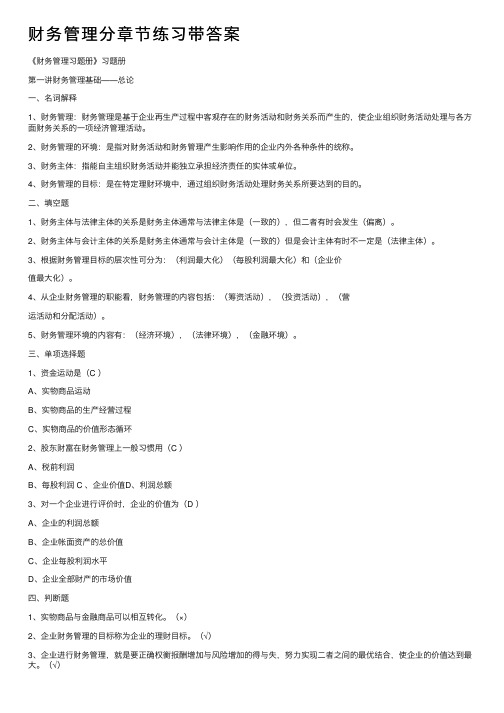
财务管理分章节练习带答案《财务管理习题册》习题册第⼀讲财务管理基础——总论⼀、名词解释1、财务管理:财务管理是基于企业再⽣产过程中客观存在的财务活动和财务关系⽽产⽣的,使企业组织财务活动处理与各⽅⾯财务关系的⼀项经济管理活动。
2、财务管理的环境:是指对财务活动和财务管理产⽣影响作⽤的企业内外各种条件的统称。
3、财务主体:指能⾃主组织财务活动并能独⽴承担经济责任的实体或单位。
4、财务管理的⽬标:是在特定理财环境中,通过组织财务活动处理财务关系所要达到的⽬的。
⼆、填空题1、财务主体与法律主体的关系是财务主体通常与法律主体是(⼀致的),但⼆者有时会发⽣(偏离)。
2、财务主体与会计主体的关系是财务主体通常与会计主体是(⼀致的)但是会计主体有时不⼀定是(法律主体)。
3、根据财务管理⽬标的层次性可分为:(利润最⼤化)(每股利润最⼤化)和(企业价值最⼤化)。
4、从企业财务管理的职能看,财务管理的内容包括:(筹资活动),(投资活动),(营运活动和分配活动)。
5、财务管理环境的内容有:(经济环境),(法律环境),(⾦融环境)。
三、单项选择题1、资⾦运动是(C )A、实物商品运动B、实物商品的⽣产经营过程C、实物商品的价值形态循环2、股东财富在财务管理上⼀般习惯⽤(C )A、税前利润B、每股利润 C 、企业价值D、利润总额3、对⼀个企业进⾏评价时,企业的价值为(D )A、企业的利润总额B、企业帐⾯资产的总价值C、企业每股利润⽔平D、企业全部财产的市场价值四、判断题1、实物商品与⾦融商品可以相互转化。
(×)2、企业财务管理的⽬标称为企业的理财⽬标。
(√)3、企业进⾏财务管理,就是要正确权衡报酬增加与风险增加的得与失,努⼒实现⼆者之间的最优结合,使企业的价值达到最⼤。
(√)6、企业偿还借款,⽀付利息或股利以及付出各种筹资费⽤的活动也属于企业的财务动动是企业财务管理的内容之⼀。
(√)7、企业价值,即企业帐⾯资产的总价值。
(财务知识)财务管理(清华大学出版社第版)习题答案
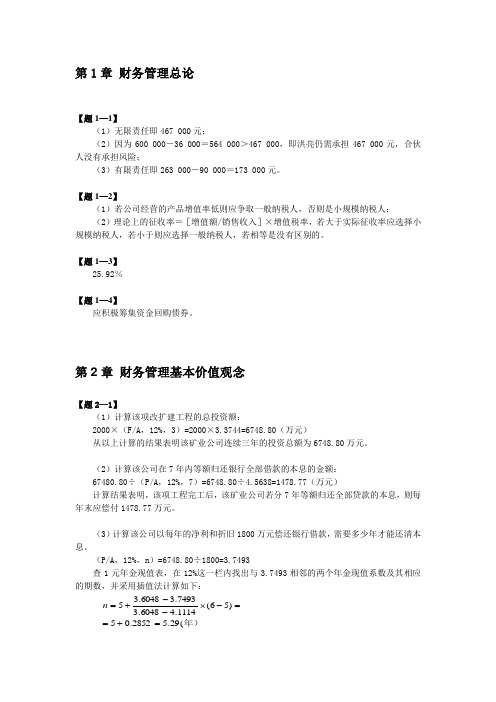
第1章 财务管理总论【题1—1】(1)无限责任即467 000元;(2)因为600 000-36 000=564 000>467 000,即洪亮仍需承担467 000元,合伙人没有承担风险;(3)有限责任即263 000-90 000=173 000元。
【题1—2】(1)若公司经营的产品增值率低则应争取一般纳税人,否则是小规模纳税人;(2)理论上的征收率=[增值额/销售收入]×增值税率,若大于实际征收率应选择小规模纳税人,若小于则应选择一般纳税人,若相等是没有区别的。
【题1—3】25.92%【题1—4】应积极筹集资金回购债券。
第2章 财务管理基本价值观念【题2—1】(1)计算该项改扩建工程的总投资额:2000×(F/A ,12%,3)=2000×3.3744=6748.80(万元)从以上计算的结果表明该矿业公司连续三年的投资总额为6748.80万元。
(2)计算该公司在7年内等额归还银行全部借款的本息的金额:67480.80÷(P/A ,12%,7)=6748.80÷4.5638=1478.77(万元)计算结果表明,该项工程完工后,该矿业公司若分7年等额归还全部贷款的本息,则每年末应偿付1478.77万元。
(3)计算该公司以每年的净利和折旧1800万元偿还银行借款,需要多少年才能还清本息。
(P/A ,12%,n )=6748.80÷1800=3.7493查1元年金现值表,在12%这一栏内找出与3.7493相邻的两个年金现值系数及其相应的期数,并采用插值法计算如下:年)(29.52852.05)56(1114.46048.37493.36048.35=+==-⨯--+=n以上计算结果表明,该公司如果每年末用1800万元来归还贷款的全部本息,需要5.29年可还清。
【题2—2】10年收益于2003年年初的现值为:800000×(P/A,6%,10)×(P/F,6%,5)=800000×7.3601×0.7473=4400162(元)或:800000×(P/A,6%,15)-800000×(P/A,6%,5) =800000×9.7122-800000×4.2124=4399840(元)【题2—3】P=3×(P/A, 6%, 6)=3×4.9173=14.7915(万元)宋女士付给甲开发商的资金现值为:10+14.7915= 24.7915 (万元)如果直接按每平方米2000元购买,宋女士只需要付出20万元,由此可见分期付款对她而言不合算。
中级会计师-财务管理-基础练习题-第十章财务分析与评价-第三节上市公司财务分析

中级会计师-财务管理-基础练习题-第十章财务分析与评价-第三节上市公司财务分析[单选题]1.下列各项中,计算结果等于股利支付率的是()。
A.每股(江南博哥)收益除以每股股利B.每股股利除以每股收益C.每股股利除以每股市价D.每股收益除以每股市价正确答案:B参考解析:股利支付率是当年发放股利与当年净利润之比,或每股股利除以每股收益。
[单选题]2.某上市公司2018年度归属于普通股股东的净利润为2950万元。
2017年年末的股本为10000万股,2018年3月5日,经公司2017年度股东大会决议,以截至2017年年末公司总股本为基础,向全体股东每10股送红股1股,工商注册登记变更完成后公司总股本变为11000万股,2018年5月1日新发行6000万股。
11月1日回购1500万股,以备将来奖励职工之用,则该上市公司基本每股收益为()元。
A.0.1B.0.2C.0.3D.0.4正确答案:B参考解析:发行在外的普通股加权平均数=11000+6000×8/12-1500×2/12=14750(万股),基本每股收益=2950/14750=0.2(元)。
由于送红股是将公司以前年度的未分配利润转为普通股,转化与否都一直作为资本使用,因此,新增的这1000万股不需要按照实际增加的月份加权计算,可以直接计入分母。
[单选题]4.下列各项财务指标中,能够综合反映企业成长性和投资风险的是()。
A.市盈率B.每股收益C.营业净利率D.每股净资产正确答案:A参考解析:一方面,市盈率越高,意味着企业未来成长的潜力越大,即投资者对该股票的评价越高,反之,投资者对该股票评价越低。
另一方面,市盈率越高,说明投资于该股票的风险越大;市盈率越低,说明投资于该股票的风险越小。
[单选题]5.某公司2017年度归属于普通股股东的净利润为500万元,发行在外普通股加权平均数为1250万股,该普通股平均每股市场价格为4元。
2017年1月1日,该公司对外发行250万份认股权证,行权日为2020年3月1日,每份认股权证可以在行权日以3.5元的价格认购本公司1股新发的股票,2017年的稀释每股收益为()元。
财务管理课后答案第十章
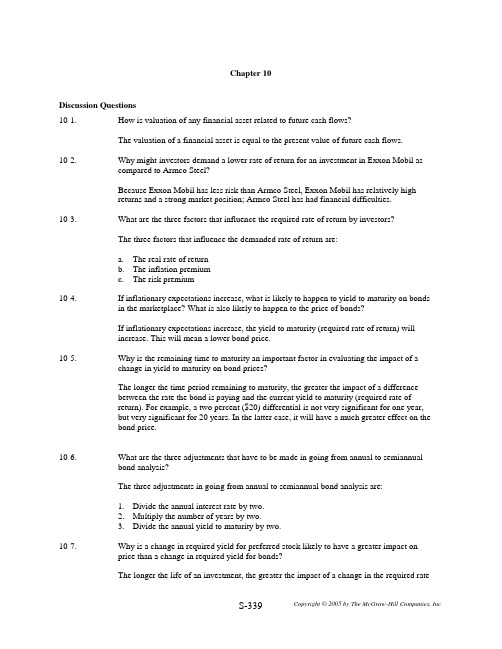
Chapter 10Discussion Questions10-1. How is valuation of any financial asset related to future cash flows?The valuation of a financial asset is equal to the present value of future cash flows.10-2. Why might investors demand a lower rate of return for an investment in Exxon Mobil as compared to Armco Steel?Because Exxon Mobil has less risk than Armco Steel, Exxon Mobil has relatively highreturns and a strong market position; Armco Steel has had financial difficulties.10-3. What are the three factors that influence the required rate of return by investors?The three factors that influence the demanded rate of return are:a.The real rate of returnb.The inflation premiumc.The risk premium10-4. If inflationary expectations increase, what is likely to happen to yield to maturity on bonds in the marketplace? What is also likely to happen to the price of bonds?If inflationary expectations increase, the yield to maturity (required rate of return) willincrease. This will mean a lower bond price.10-5. Why is the remaining time to maturity an important factor in evaluating the impact of a change in yield to maturity on bond prices?The longer the time period remaining to maturity, the greater the impact of a differencebetween the rate the bond is paying and the current yield to maturity (required rate ofreturn). For example, a two percent ($20) differential is not very significant for one year,but very significant for 20 years. In the latter case, it will have a much greater effect on thebond price.10-6. What are the three adjustments that have to be made in going from annual to semiannual bond analysis?The three adjustments in going from annual to semiannual bond analysis are:1.Divide the annual interest rate by two.2.Multiply the number of years by two.3.Divide the annual yield to maturity by two.10-7. Why is a change in required yield for preferred stock likely to have a greater impact on price than a change in required yield for bonds?The longer the life of an investment, the greater the impact of a change in the required rateof return. Since preferred stock has a perpetual life, the impact is likely to be at a maximum.10-8.What type of dividend pattern for common stock is similar to the dividend payment for preferred stock?The no-growth pattern for common stock is similar to the dividend on preferred stock.10-9.What two conditions must be met to go from Formula 10-8 to Formula 10-9 in using the dividend valuation model?()910g-K D P e 10-=To go from Formula (10-8) to Formula (10-9):The firm must have a constant growth rate (g).The discount rate (k e ) must exceed the growth rate (g).10-10.What two components make up the required rate of return on common stock?The two components that make up the required return on common stock are:a. The dividend yield D 1/P o .b. The growth rate (g). This actually represents the anticipated growth in dividends,earnings, and stock price over the long term.10-11.What factors might influence a firm's price-earnings ratio?The price-earnings ratio is influenced by the earnings and sales growth of the firm, the risk (or volatility in performance), the debt-equity structure of the firm, the dividend policy, the quality of management, and a number of other factors. Firms that have bright expectations for the future tend to trade at high P/E ratios while the opposite is true of low P/E firms.10-12.How is the supernormal growth pattern likely to vary from the normal, constant growth pattern?A supernormal growth pattern is represented by very rapid growth in the early years of a company or industry that eventually levels off to more normal growth. The supernormal growth pattern is often experienced by firms in emerging industries, such as in the early days of electronics or microcomputers.10-13.What approaches can be taken in valuing a firm's stock when there is no cash dividend payment?In valuing a firm with no cash dividend, one approach is to assume that at some point in the future a cash dividend will be paid. You can then take the present value of future cash dividends.A second approach is to take the present value of future earnings as well as a futureanticipated stock price. The discount rate applied to future earnings is generally higher thanthe discount rate applied to future dividends.Problems(For the first nine bond problems, assume interest payments are on an annual basis.)10-1. Burns Fire and Casualty Company has $1,000 par value bonds outstanding at 11 percent interest. The bonds will mature in 20 years. Compute the current price of the bonds if thepresent yield to maturity is:a. 6 percent.b. 8 percent.c. 12 percent.Solution:Burns Fire and Casualty Companya. 6 percent yield to maturityPresent Value of Interest PaymentsPV A = A x PV IFA (n = 20, i = 6%) Appendix D PV A = $110 x 11.470 = $1,261.70Present Value of Principal Payment at MaturityPV = FV x FV IF (n = 20, i = 6%) Appendix B PV = 1,000 x .312 = $312Present Value of Interest Payment $1,261.70 Present Value of Principal Payment 312.00 Total Present Value or Price of the Bond $1,573.70 10-1. Continuedb. 8 percent yield to maturityPV A = A x PV IFA (n = 20, i = 8%) Appendix D PV A = $110 x 9.818 = $1,079.98PV = FV x PV IF (n = 20, i = 8%) Appendix B PV = $1,000 x .215 = $215$1,079.98215.00$1,294,88 c. 12 percent yield to maturityPV A = A x PV IFA (n = 20, i = 12%) Appendix D PV A = $110 x 7.469 = $821.59PV = FV x PV IF (n = 20, i = 12%) Appendix B PV = $1,000 x .104 = $104$821.59104.00$925.59 10-2. Midland Oil has $1,000 par value bonds outstanding at 8 percent interest. The bonds will mature in 25 years. Compute the current price of the bonds if the present yield to maturityis:a. 7 percent.b. 10 percent.c. 13 percent.Solution:Midland Oila. 7 percent yield to maturityPresent Value of Interest PaymentsPV A = A x PV IFA (n = 25, i = 7%) Appendix D PV A = $80 x 11.654 = $932.32Present Value of Principal Payment at MaturityPV = FV x PV IF (n = 25, i = 7%) Appendix BPV = $1,000 x .184 = $184Total Present ValuePresent Value of Interest Payments $ 932.32 Present Value of Principal Payments 184.00 Total Present Value or Price of the Bond $1,116.32 b. 10 percent yield to maturityPV A = A x PV IFA (n = 25, i = 10%) Appendix D PV A = $80 x 9.077 = $726.16PV = FV x PV IF (n = 25, i = 10%) Appendix B PV = $1,000 x .092 = $92$726.1692.00$818.16 10-2. Continuedc. 13 percent yield to maturityPV A = A x PV IFA (n = 25, i = 13%) Appendix D PV A = $80 x 7.330 = $586.40PV = FV x PV IF (n = 25, i = 13%) Appendix B PV = $1,000 x .047 = $47$586.4047.00$633.4010-3. Exodus Limousine Company has $1,000 par value bonds outstanding at 10 percent interest.The bonds will mature in 50 years. Compute the current price of the bonds if the percentyield to maturity is:a. 5 percent.b. 15 percent.Solution:Exodus Limousine Companya. 5 percent yield to maturityPresent Value of Interest PaymentsPV A = A x PV IFA (n = 50, i = 5%) Appendix D PV A = $100 x 18.256 = $1,825.60Present Value of Principal PaymentPV = FV x PV IF (n = 50, i = 5%) Appendix B PV = $1,000 x .087 = $87Present Value of Interest Payment $1,825.60 Present Value of Principal Payment 87.00 Total Present Value or Price of the Bond $1,912.6010-3. Continuedb. 15 percent yield to maturityPresent Value of Interest PaymentsPV A = A x PV IFA (n = 50, i = 15%) Appendix D PV A = $1,000 x 6.661 = $666.10PV = FV x PV IF (n = 50, i = 15%) Appendix B PV = $1,000 x .001 = $1Present Value of Interest Payment $666.10 Present Value of Principal Payment 1.00 Total Present Value or Price of the Bond $667.10 10-4. Harrison Ford Auto Company has a $1,000 par value bond outstanding that pays 11 percent interest. The current yield to maturity on each bond in the market is 8 percent.Compute the price of these bonds for these maturity dates:a. 30 years.b. 15 years.c. 1 year.Solution:Harrison Ford Auto Companya. 30 years to maturityPresent Value of Interest PaymentsPV A = A x PV IFA (n = 30, i = 8%) Appendix DPV A = $110 x 11.258 = $1,238.38Present Value of Principal PaymentPV = FV x PV IF (n = 30, i = 8%) Appendix B PV = $1,000 x .099 = $9910-4. ContinuedTotal Present ValuePresent Value of Interest Payment $1,238.38 Present Value of Principal Payment 99.00 Total Present Value or Price of the Bond $1,337.38 b. 15 years to maturityPV A = A x PV IFA (n = 15, i = 8%) Appendix D PV A = $110 x 8.559 = $941.49PV = FV x PV IF (n = 15, i = 8%) Appendix B PV = $1,000 x .315 = $315$ 941.49315.00$1,256.49 c. 1 year to maturityPV A = A x PV IFA (n = 1, i = 8%) Appendix D PV A = $110 x .926 = $101.86PV = FV x PV IF (n = 1, i = 8%) Appendix B PV = $1,000 x .926 = $926.00$ 101.86926.00$1,027.86 10-5. Kilgore Natural Gas has a $1,000 par value bond outstanding that pays 9 percent annual interest. The current yield to maturity on such bonds in the market is 12 percent. Computethe price of the bonds for these maturity dates:a. 30 years.b. 15 years.c. 1 year.Solution:Kilgore Natural Gasa. 30 years to maturityPresent Value of Interest PaymentsPV A = A x PV IFA (n = 30, i = 12%) Appendix D PV A = $90 x 8.055 = $724.95PV = FV x PV IF (n = 30, i = 12%) Appendix B PV = $1,000 x .033 = $33Total Present ValuePresent Value of Interest Payments $724.95 Present Value of Principal Payment 33.00 Total Present Value or Price of the Bond $757.95b. 15 years to maturityPV A = A x PV IFA (n = 15, i = 12%) Appendix D PV A = $90 x 6.811 = $612.99PV = FV x PV IF (n = 15, i = 12%) Appendix B PV = $1,000 x .183 = $183 $612.99 183.00 $795.9910-5. Continuedc. 1 year to maturity PV A = A x PV IFA Appendix D PV A = $90 x .893 = $80.37PV = FV x PV IF Appendix B PV = $1,000 x .893 = $893.00 $ 80.37 893.00 $973.37 10-6. For Problem 5 graph the relationship in a manner similar to the bottom half. of Figure 10-2.Also explain why the pattern of price change occurs.Solution:Kilgore Natural Gas (Continued)30 25 15 5 0$1,000 Years10-7.Go to Table 10-1 which is based on bonds paying 10 percent interest for 20 years. Assume interest rates in the market (yield to maturity) decline from 11 percent to 8 percent:a. What is the bond price at 11 percent?b. What is the bond price at 8 percent?c. What would be your percentage return on investment if you bought when rates were 11percent and sold when rates were 8 percent?Solution:a. $920.30b. $1,196.80c. Sales price (8%) $1,196.80 Purchase price (11%) 920.30 Profit $ 276.50%04.3030.920$50.276$Price Purchase Profit ==10-8.Using Table 10-2:a. Assume the interest rate in the market (yield to maturity) goes down to 8 percent forthe 10 percent bonds. Using column 2, indicate what the bond price will be with a 5-year, a 15-year, and a 30-year time period.b. Assume the interest rate in the market (yield to maturity) goes up to 12 percent for the10 percent bonds. Using column 3, indicate what the bond price will be with a 5-year, a 10-year, and a 30-year period.c. Based on the information in part a , if you think interest rates in the market are goingdown, which bond would you choose to own?d. Based on information in part b , if you think interest rates in the market are going up,which bond would you choose to own?Solution: a.MaturityBond price 5 year $1,080.30 15 year 1,170.9030 year1,224.80b. . MaturityBond price 5 year 927.50 15 year 864.11 30 year 838.50c. Based on information in Part a, you would want to own the longest-term bond possible to maximizeyour gain.d. Based on information in Part b, you would want to own the shortest-term bond possible to minimizeyour loss.10-9. Jim Busby calls his broker to inquire about purchasing a bond of Disk Storage Systems.His broker quotes a price of $1,180. Jim is concerned that the bond might be overpricedbased on the facts involved. The $1,000 par value bond pays 14 percent interest, and it has25 years remaining until maturity. The current yield to maturity on similar bonds is 12percent. Compute the new price of the bond and comment on whether you think it isoverpriced in the marketplace.Solution:Jim Busby – Disk Storage SystemsPresent Value of Interest PaymentsPV A = A x PV IFA (n = 25, i = 12%) Appendix D PV A = $140 x 7.843 = $1,098.02Present Value of Principal Payment at MaturityPV = FV x PV IF (n = 25, i = 12%) Appendix B PV = $1,000 x .059 = $59$1,098.0259.00$1,157.02 The bond has a value of $1,157.02. This indicates his broker is quoting too high a price at $1,180.10-10. Tom Cruise Lines, Inc., issued bonds five years ago at $1,000 per bond. These bonds had a 25-year life when issued and the annual interest payment was then 12 percent. This returnwas in line with the required returns by bondholders at that point as described below:Real rate of return .................................................... 3%Inflation premium (5)Risk premium (4)Total return ............................................................ 12%Assume that five years later the inflation premium is only 3 percent and is appropriatelyreflected in the required return (or yield to maturity) of the bonds. The bonds have 20 yearsremaining until maturity.Compute the new price of the bond.Solution:Tom Cruise Lines, Inc.First compute the new required rate of return (yield to maturity).Real rate of return 3%Inflation premium 3Risk premium 4Total return 10%Then use this value to find the price of the bond.Present Value of Interest PaymentsPV A = A x PV IFA (n = 20, i = 10%) Appendix D PV A = $120 x 8.514 = $1,021.68Present Value of Principal Payment at MaturityPV = FV x PV IF (n = 20, i = 10%) Appendix B PV = $1,000 x .149 = $149$1,021.68149.00$1,170.68 10-11. Further analysis of problem 10:a. Find the present value of 2 percent x $1,000 (or $20) for 20 years at 10 percent. The$20 is assumed to be an annual payment.b. Add this value to $1,000.c. Explain why the answers to problem 11b and problem 10 are basically the same.(There is a slight difference due to rounding in the tables.)Solution:Further Analysis of Problem 10a. PV A = A x PV IFA (n = 20, i = 10%) Appendix DPV A = $20 x 8.514 = $170.28b. $1,000.00170.28$1,170.28c. The answer to problem 11b of $1,170.28 and problem 10 of $1,170.68 are basically the same because inboth cases we are valuing the present value of a $20 differential between actual return and required return for 20 years.In problem 11b we take the present value of the $20 differential to arrive at $170.28. We then add this value to the $1,000.00 par value to determine a value of $1,170.28.In problem 10, we accomplish the same goal by valuing all future benefits at a two percent differential between actual return and required return to arrive at $1,170.68.10-12. Wilson Oil Company issued bonds five years ago at $1,000 per bond. These bonds had a 25 year life when issued and the annual interest payment was then 8 percent. This return was inline with the required returns by bondholders at that point in time as described below:Real rate of return .................................................... 2%Inflation premium (3)Risk premium (3)Total return ............................................................ 8%Assume that 10 years later, due to bad publicity, the risk premium is now 6 percent and isappropriately reflected in the required return (or yield to maturity) of the bonds. The bondshave 15 years remaining until maturity. Compute the new price of the bond.Solution:Wilson Oil CompanyFirst compute the new required rate of return (yield to maturity).Real rate of return 2% Inflation premium 3% Risk premium 6% 11% total required returnThen use this value to find the price of the bond.Present Value of Interest Payments PV A = A x PV IFA (n = 15, i = 11%) Appendix D PV A = $80 x 7.191 = $575.28Present Value of Principal Payment at Maturity PV = FV x PV IF (n = 15, i = 11%) Appendix B PV = $1,000 x .209 = $209.00 $575.28 209.00 Bond Price = $784.2810-13. Bonds issued by the Crane Optical Company have a par value of $1,000, which is also theamount of principal to be paid at maturity. The bonds are currently selling for $850. They have 10 years remaining to maturity. The annual interest payment is 9 percent ($90). Compute the approximate yield to maturity, using Formula 10-2.Solution:Crane Optical CompanyApproximate Yield to Maturity is represented by Y'payment)(Principal .4 bond) the of (Price .6maturity to years of Number bondthe of Price payment Principal payment interest Annual Y'+-+=()()%54.11910$105$910$1590$400510$10150$90$000,1$ 4.850$ 6.10850000,1$90$==+=++=+-+=10-14.Bonds issued by the West Motel Chain have a par value of $1,000, are selling for $1,100, and have 20 years remaining to maturity. The annual interest payment is 13.5 percent ($135). Compute the approximate yield to maturity, using Formula 10-2 on page 277.Solution:West Motel ChainApproximate Yield to Maturity is represented by Y'payment)(Principal .4 bond) the of (Price .6maturityto years of Number bondthe of Price payment Principal payment interest Annual Y'+-+=()()%26.12060,1$130$060,1$5135$400660$20100$135$000,1$ 4.100,1$ 6.20100,1000,1$135$==-=+-+=+-+=10-15.Optional —for Problem 14, use the techniques in Appendix 10A to combine a trial and error approach with interpolation to find a more exact answer. You may choose to use a handheld calculator instead.Solution:West Motel Chain (Continued)In using the trial and error approach in this instance, we can reasonably infer the answer is between 12 and 13 percent based on the information in problem 14. Even if we did not have this information, we could infer the yield is somewhat below 13.5 percent because the bonds are trading above the par value of $1,000. Let'sbegin the trial and error process at 12 percent.Present Value of Interest PaymentsPV A = A x PV IFA (n = 20, i = 12%) Appendix D PV A = $135 x 7.469 = $1,008.32Present Value of Principal Payment at MaturityPV = FV x PV IFPV = $1,000 x .104 = $104$1,008.32104.00$1,112.32 The discount rate of 12 percent gives us too high a present value in comparison to the bond price of $1,100. So we next use a higher rate of 13 percent.Present Value of Interest PaymentsPV A = A x PV IFA (n = 20, i = 13%) Appendix D PV A = $135 x 7.025 = $948.3810-15. ContinuedPresent Value of Principal Payment at MaturityPV = FV x PV IF (n = 20, i = 13%) Appendix B PV = $1,000 x .087 = $87$ 948.3887.00$1,035.38 The discount rate of 13 percent provides too low a value. The actual value falls between 12 and 13 percent. Using interpolation:$1,112.32 PV at 12% $1,112.32 PV at 12%–1,035.38 PV at 13% –1,100.00 bond price$ 76.94 $ 12.3212% + $12.32/$76.94 (1%) = 12% + .16 (1%) = 12.16%The answer is 12.16%.(For the next two problems, assume interest payments are on a semiannual basis.)10-16. Robert Brown III is considering a bond investment in Southwest Technology Company. The $1,000 bonds have a quoted annual interest rate of 8 percent and interest is paid semiannually.The yield to maturity on the bonds is 10 percent annual interest. There are 25 years tomaturity. Compute the price of the bonds based on semiannual analysis.Solution:Robert Brown III—Southwest Technology8% interest/2 = 4% semiannual interest rate4% x $1,000 = $40 semiannual interest25 x 2 = 50 number of periods (n)10%/2 = 5% yield to maturity expressed on a semiannual basis (i)Present Value of Interest PaymentsPV A = A x PV IFA (n = 50, i = 5%) Appendix D PV A = $40 x 18.256 = $730.24Present Value of Principal Payment at MaturityPV = FV x PV IF (n = 50, i = 5%) Appendix B PV = $1,000 x .087 = $87$730.2487.00$817.24 10-17. You are called in as a financial analyst to appraise the bonds of the Holtz Corporation. The $1,000 par value bonds have a quoted annual interest rate of 14 percent, which is paidsemiannually. The yield to maturity on the bonds is 12 percent annual interest. There are 15years to maturity.a. Compute the price of the bonds based on semiannual analysis.b. With 12 years to maturity, if yield to maturity goes down substantially to 8 percent,what will be the new price of the bonds?Solution:Holtz Corporationa. Present Value of Interest PaymentsPV A = A x PV IFA (n = 30, i = 6%) Appendix D PV A = $70 x 13.765 = $963.55Present Value of Principal Payment at MaturityPV = FV x PV IF (n = 30, i = 6%) Appendix B PV = $1,000 x .174 = $174$ 963.55174.00$1,137.55 b. PV A = A x PV IFA (n = 20, i = 4%) Appendix DPV A = $70 x 13.590 = $951.30PV = FV x PV IF (n = 20, i = 4%) Appendix B PV = $1,000 x .456 = $456$ 951.30456.00$1,407.30 10-18. The preferred stock of Ultra Corporation pays an annual dividend of $6.30. It has a requiredrate of return of 9 percent. Compute the price of the preferred stock.Solution:Ultra Corp.70$09.30.6$K D P p p p ===10-19.North Pole Cruise Lines issued preferred stock many years ago. It carries a fixed dividend of $6 per share. With the passage of time, yields have soared from the original 6 percent to 14 percent (yield is the same as required rate of return).a. What was the original issue price?b. What is the current value of this preferred stock?c. If the yield on the Standard & Poor's Preferred Stock Index declines, how will the priceof the preferred stock be affected?Solution: North Pole Cruise Linesa. Original price100$06.00.6$K D P p p p ===b. Current value86.42$14.00.6$=c. The price of preferred stock will increase as yields decline. Since preferred stock is a fixed incomesecurity, its price is inversely related to yields as would be true with bond prices. The present value of an income stream has a higher present value as the discount rate declines, and a lower present value as the discount rate increases. 10-20. Venus Sportswear Corporation has preferred stock outstanding that pays an annual dividendof $12. It has a price of $110. What is the required rate of return (yield) on the preferred stock?Solution:Venus Sportswear Corporation%91.10110$12$P D K p p p ===10-21.Analogue Technology has preferred stock outstanding that pays a $9 annual dividend. It has a price of $76. What is the required rate of return (yield) on the preferred stock?Solution:Analogue Technology%84.1176$9$P D K p p p ===(All of the following problems pertain to the common stock section of the chapter.)10-22.Static Electric Co. currently pays a $2.10 annual cash dividend (D 0). It plans to maintain the dividend at this level for the foreseeable future as no future growth is anticipated. If the required rate of return by common stockholders (K e ) is 12 percent, what is the price of the common stock?Solution:Static Electric Co.50.17$12.10.2$K D P e 00===10-23.BioScience, Inc., will pay a common stock dividend of $3.20 at the end of the year (D 1).The required return on common stock (K e ) is 14 percent. The firm has a constant growth rate (g) of 9 percent. Compute the current price of the stock (P 0).Solution:BioScience Inc.00.64$05.20.3$09.14.20.3$K D P g -e 10==-==10-24.Friedman Steel Company will pay a dividend of $1.50 per share in the next 12 months (D 1). The required rate of return (K e ) is 10 percent and the constant growth rate is 5 percent.a. Compute P 0.(For parts b, c, and d in this problem all variables remain the same except the one specifically changed. Each question is independent of the others.)b. Assume K e , the required rate of return, goes up to 12 percent, what will be the newvalue of P 0?c. Assume the growth rate (g) goes up to 7 percent, what will be the new value of P 0?d. Assume D 1 is $2, what will be the new value of P 0?10-24. ContinuedSolution:Friedman Steel CompanygK D P e 10-=00.40$05.00.2$05.10.00.2$ d.00.50$03.50.1$07.10.50.1$ c.43.21$07.50.1$05.12.50.1$ b.00.30$05.50.1$05.10.50.1$ a.==-==-==-==-10-25. Maxwell Communications paid a dividend of $3 last year. Over the next 12 months, thedividend is expected to grow at 8 percent, which is the constant growth rate for the firm (g). The new dividend after 12 months will represent D 1. The required rate of return (K e ) is 14 percent. Compute the price of the stock (P 0).Solution:Maxwell Communications()()54$06.024.3$08.14.24.3$P 24.3$08.1 00.3$g 1 D D gK D P 001e 1==-===+=-=10-26.Haltom Enterprises has had the following pattern of earnings per share over the last five years: Year Earnings per Share 2000 ............................................. $3.00 2001 ............................................. 3.18 2002 ............................................. 3.37 2003 ............................................. 3.57 2004 ............................................. 3.78The earnings per share have grown at a constant rate (on a rounded basis) and will continue to do so in the future. Dividends represent 30 percent of earnings.a. Project earnings and dividends for the next year (2005). Round all values in thisproblem to two places to the right of the decimal point.b. If the required rate of return (K e ) is 10 percent, what is the anticipated stock price at thebeginning of 2005?10-26. ContinuedSolution:Haltom Enterprisesa. Earnings have been growing at a rate of 6 percent per year.2000 Base Period 2001 $3.18/3.00 6% growth 2002 $3.37/3.18 6% growth 2003 $3.57/3.37 6% growth 2004 $3.78/3.57 6% growthThe projected EPS for 2005 is $3.78 (1.06) = $4.01Dividend for 2005 represent 30% of earnings or $1.20.This is the value for D 1.b. K e (required rate of return) is 10% and the growth rate is 6%.()30$04.20.1$06.10.20.1$g K D 2005 P e 10==-=-=10-27. A firm pays a $4.90 dividend at the end of year one (D 1), has a stock price of $70, and a constant growth rate (g) of 6 percent. Compute the required rate of return.Solution:%13%6%7%600.70$90.4$K g P D K e 01e =+=+=+=10-28.A firm pays a $1.90 dividend at the end of year one (D 1), has a stock price of $40 (P 0), and a constant growth rate (g) of 8 percent.a. Compute the required rate of return (K e ). Also indicate whether each of the followingchanges would make the required rate of return (K e ) go up or down. (For parts b , c , and d below, assume only one variable changes at a time. No actual numbers are necessary.)b. The dividend payment increases.c. The expected growth rate increases.d. The stock price increases.Solution:%75.12%8%75.4%800.40$90.1$K g P D K a.e 01e =+=+=+=b. If the dividend payment increases, the dividend yield (D 1/P 0) will go up, and the required rate of return(K e ) will also go up.10-28. Continuedc. If the expected growth rate (g) increases, the required rate of return (K e ) will go up.d. If the stock price increases, the dividend yield (D 1/P 0) will go down, and the required rate of return (K e )will also go down. 10-29. Cellular Systems paid a $3 dividend last year. The dividend is expected to grow at aconstant rate of 5 percent over the next three years. The required rate of return is 12 percent (this will also serve as the discount rate in this problem). Round all values to three places to the right of the decimal point where appropriate.a. Compute the anticipated value of the dividends for the next three years. That is,compute D 1, D 2, and D 3; for example, D 1 is $3.15 ($3.00 x 1.05). Round all values throughout this problem to three places to the right of the decimal point.b. Discount each of these dividends back to the present at a discount rate of 12 percentand then sum them.c. Compute the price of the stock at the end of the third year (P 3).g-=e 43K D P(D 4 is equal to D 3 times 1.05)d. After your have computed P 3, discount it back to the present at a discount rate of 12percent for three years.e. Add together the answers in part b and part d to get P 0, the current value of the stock.This answer represents the present value of the first three periods of dividends, plus the present value of the price of the stock after three periods (which, in turn, represents the value of all future dividends).f. Use Formula 10-9 to show that it will provide approximately the same answer as part e .gK D P e 10-=For Formula 10-9 use D 1 = $3.15, K e = 12 percent, and g = 5 percent. (The slight difference。
财务管理课后答案 第十章

第十章财务控制与评价思考练习一、单项选择题1.A 2.D 3.D 4.B 5.A 6.A7.B 8.C 9.C 10.D 11.D 12.B二、多项选择题1.AC2.ACD 3.ABD 4.BCD 5.BCD 6.ACD7.ABC 8.AD 9.BD 10.CD 11.AC 12.ABC三、判断题1-5.√×√√√ 6-10.×××√× 11-15 ××√××四、计算题1.(1)填列表格如下:单位:万元项目总资产息税前利润息税前利润率剩余收益甲投资中心500 40乙投资中心 1000 86追加投资前 1000 150 8% -10追加投资后86/1000×100%=8.6%86-1000×10%=-14追加投资前 1500 205 15% +50追加投资后205/1500×100%=13.67% 205-1500×10%=55(2)决策如下:由于甲投资中心追加投资后将降低剩余收益,故不应追加投资;乙投资中心追加投资后可提高剩余收益,故可追加投资。
2.(1)①该投资中心的投资报酬率=(150000-100000-8000-25000)/100000=17%②公司规定该中心的最低报酬率=8%+1.5×(10%-8%)=11%③剩余收益=17000-100000×11%=6000(元)(2)追加投资后的指标计算如下:①投资报酬率=[150000-100000-8000-25000]+9000]/(100000+60000)=26000/160000=16.25%②剩余收益=26000-160000×11%=8400(元)由于追加投资后的投资报酬率低于变动前的,故根据投资报酬率决策,该项目不可行;追加投资后的剩余收益高于变动前的,故根据剩余收益决策,该项目是可行的。
电大财务管理各章练习及答案
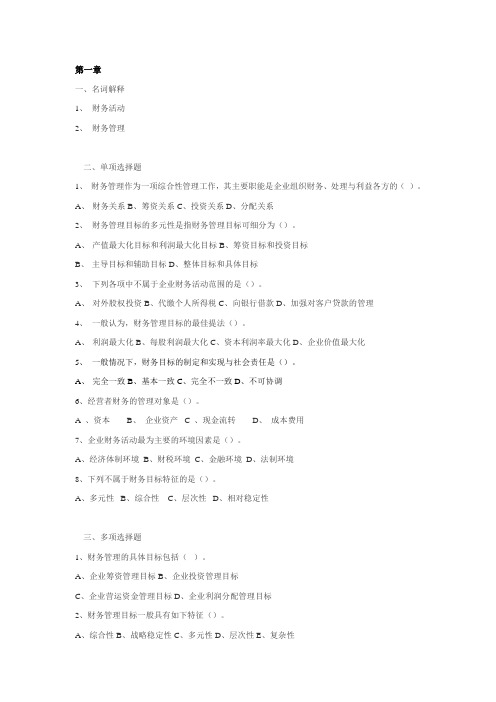
第一章一、名词解释1、财务活动2、财务管理二、单项选择题1、财务管理作为一项综合性管理工作,其主要职能是企业组织财务、处理与利益各方的()。
A、财务关系B、筹资关系C、投资关系D、分配关系2、财务管理目标的多元性是指财务管理目标可细分为()。
A、产值最大化目标和利润最大化目标B、筹资目标和投资目标B、主导目标和辅助目标D、整体目标和具体目标3、下列各项中不属于企业财务活动范围的是()。
A、对外股权投资B、代缴个人所得税C、向银行借款D、加强对客户贷款的管理4、一般认为,财务管理目标的最佳提法()。
A、利润最大化B、每股利润最大化C、资本利润率最大化D、企业价值最大化5、一般情况下,财务目标的制定和实现与社会责任是()。
A、完全一致B、基本一致C、完全不一致D、不可协调6、经营者财务的管理对象是()。
A 、资本B、企业资产 C 、现金流转D、成本费用7、企业财务活动最为主要的环境因素是()。
A、经济体制环境B、财税环境C、金融环境D、法制环境8、下列不属于财务目标特征的是()。
A、多元性B、综合性C、层次性D、相对稳定性三、多项选择题1、财务管理的具体目标包括()。
A、企业筹资管理目标B、企业投资管理目标C、企业营运资金管理目标D、企业利润分配管理目标2、财务管理目标一般具有如下特征()。
A、综合性B、战略稳定性C、多元性D、层次性E、复杂性3、财务管理环境包括()。
A、经济体制环境B、经济结构环境C、财税环境D、金融环境E、法律制度环境4、企业筹措资金的形式有()。
A、发行股票B、企业内部留存收益C、银行借款D、发行债券E、应付款项财务经理财务职责包括()。
A、现金管理B、信用管理C、筹资D、具体利润分配E、财务预测、财务计划和财务分析5、企业财务分层管理具体为()。
A、出资者财务管理B、经营者财务管理C、财务经理财务管理D、债务人财务管理E、职工财务管理四、简答题1、为什么企业价值最大化是较为合理的财务管理目标?一、名词解释1、答:是指资金的运筹、运用、收回及分配等一系列行为。
财务管理学课后习题答案
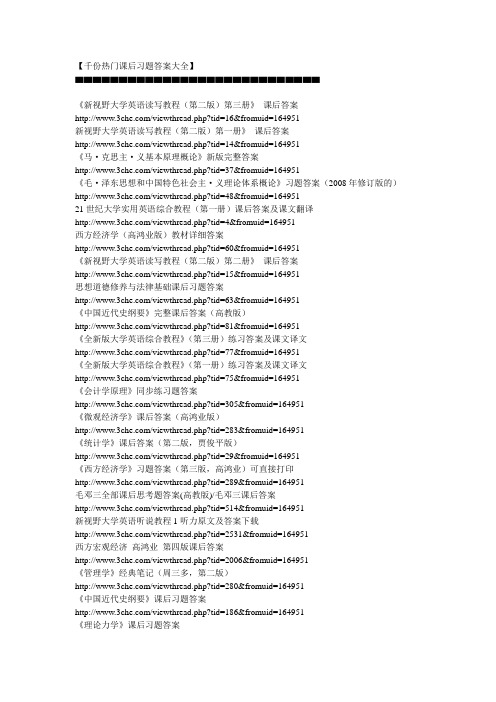
【千份热门课后习题答案大全】▆▆▆▆▆▆▆▆▆▆▆▆▆▆▆▆▆▆▆▆▆▆▆▆▆▆▆▆《新视野大学英语读写教程(第二版)第三册》课后答案/viewthread.php?tid=16&fromuid=164951新视野大学英语读写教程(第二版)第一册》课后答案/viewthread.php?tid=14&fromuid=164951《马·克思主·义基本原理概论》新版完整答案/viewthread.php?tid=37&fromuid=164951《毛·泽东思想和中国特色社会主·义理论体系概论》习题答案(2008年修订版的)/viewthread.php?tid=48&fromuid=16495121世纪大学实用英语综合教程(第一册)课后答案及课文翻译/viewthread.php?tid=4&fromuid=164951西方经济学(高鸿业版)教材详细答案/viewthread.php?tid=60&fromuid=164951《新视野大学英语读写教程(第二版)第二册》课后答案/viewthread.php?tid=15&fromuid=164951思想道德修养与法律基础课后习题答案/viewthread.php?tid=63&fromuid=164951《中国近代史纲要》完整课后答案(高教版)/viewthread.php?tid=81&fromuid=164951《全新版大学英语综合教程》(第三册)练习答案及课文译文/viewthread.php?tid=77&fromuid=164951《全新版大学英语综合教程》(第一册)练习答案及课文译文/viewthread.php?tid=75&fromuid=164951《会计学原理》同步练习题答案/viewthread.php?tid=305&fromuid=164951《微观经济学》课后答案(高鸿业版)/viewthread.php?tid=283&fromuid=164951《统计学》课后答案(第二版,贾俊平版)/viewthread.php?tid=29&fromuid=164951《西方经济学》习题答案(第三版,高鸿业)可直接打印/viewthread.php?tid=289&fromuid=164951毛邓三全部课后思考题答案(高教版)/毛邓三课后答案/viewthread.php?tid=514&fromuid=164951新视野大学英语听说教程1听力原文及答案下载/viewthread.php?tid=2531&fromuid=164951西方宏观经济高鸿业第四版课后答案/viewthread.php?tid=2006&fromuid=164951《管理学》经典笔记(周三多,第二版)/viewthread.php?tid=280&fromuid=164951《中国近代史纲要》课后习题答案/viewthread.php?tid=186&fromuid=164951《理论力学》课后习题答案《线性代数》(同济第四版)课后习题答案(完整版)/viewthread.php?tid=17&fromuid=164951高等数学(同济第五版)课后答案(PDF格式,共527页)/viewthread.php?tid=18&fromuid=164951中国近现代史纲要课后题答案/viewthread.php?tid=5900&fromuid=164951曼昆《经济学原理》课后习题解答/viewthread.php?tid=85&fromuid=16495121世纪大学英语读写教程(第三册)参考答案/viewthread.php?tid=5&fromuid=164951谢希仁《计算机网络教程》(第五版)习题参考答案(共48页)/viewthread.php?tid=28&fromuid=164951《概率论与数理统计》习题答案/viewthread.php?tid=57&fromuid=164951《模拟电子技术基础》详细习题答案(童诗白,华成英版,高教版)/viewthread.php?tid=42&fromuid=164951《机械设计》课后习题答案(高教版,第八版,西北工业大学)/viewthread.php?tid=96&fromuid=164951《大学物理》完整习题答案/viewthread.php?tid=217&fromuid=164951《管理学》课后答案(周三多)/viewthread.php?tid=304&fromuid=164951机械设计基础(第五版)习题答案[杨可桢等主编]/viewthread.php?tid=23&fromuid=164951程守洙、江之永主编《普通物理学》(第五版)详细解答及辅导/viewthread.php?tid=3&fromuid=164951新视野大学英语课本详解(四册全)/viewthread.php?tid=1275&fromuid=16495121世纪大学英语读写教程(第四册)课后答案/viewthread.php?tid=7&fromuid=164951新视野大学英语读写教程3册的课后习题答案/viewthread.php?tid=805&fromuid=164951新视野大学英语第四册答案(第二版)/viewthread.php?tid=5310&fromuid=164951《中国近现代史》选择题全集(共含250道题目和答案)/viewthread.php?tid=181&fromuid=164951《电工学》课后习题答案(第六版,上册,秦曾煌主编)/viewthread.php?tid=232&fromuid=164951完整的英文原版曼昆宏观、微观经济学答案/viewthread.php?tid=47&fromuid=164951《数字电子技术基础》习题答案(阎石,第五版)/viewthread.php?tid=90&fromuid=164951《电路》习题答案上(邱关源,第五版)《电工学》习题答案(第六版,秦曾煌)/viewthread.php?tid=112&fromuid=16495121世纪大学英语读写教程(第三册)课文翻译/viewthread.php?tid=6&fromuid=164951《生物化学》复习资料大全(3套试卷及答案+各章习题集)/viewthread.php?tid=258&fromuid=164951《模拟电子技术基础》课后习题答案(共10章)/viewthread.php?tid=21&fromuid=164951《概率论与数理统计及其应用》课后答案(浙江大学盛骤谢式千编著)/viewthread.php?tid=178&fromuid=164951《理论力学》课后习题答案(赫桐生,高教版)/viewthread.php?tid=119&fromuid=164951《全新版大学英语综合教程》(第四册)练习答案及课文译文/viewthread.php?tid=78&fromuid=164951《化工原理答案》课后习题答案(高教出版社,王志魁主编,第三版)/viewthread.php?tid=195&fromuid=164951《国际贸易》课后习题答案(海闻P.林德特王新奎)/viewthread.php?tid=290&fromuid=164951大学英语综合教程1-4册练习答案/viewthread.php?tid=1282&fromuid=164951《流体力学》习题答案/viewthread.php?tid=83&fromuid=164951《传热学》课后习题答案(第四版)/viewthread.php?tid=200&fromuid=164951高等数学习题答案及提示/viewthread.php?tid=260&fromuid=164951《高分子化学》课后习题答案(第四版,潘祖仁主编)/viewthread.php?tid=236&fromuid=164951马·克思主·义基本原理概论答案/viewthread.php?tid=6417&fromuid=164951《计算机网络》课后习题解答(谢希仁,第五版)/viewthread.php?tid=3434&fromuid=164951《概率论与数理统计》优秀学习资料/viewthread.php?tid=182&fromuid=164951《离散数学》习题答案(高等教育出版社)/viewthread.php?tid=102&fromuid=164951《模拟电子技术基础简明教程》课后习题答案(杨素行第三版)/viewthread.php?tid=41&fromuid=164951《信号与线性系统分析》习题答案及辅导参考(吴大正版)/viewthread.php?tid=74&fromuid=164951《教育心理学》课后习题答案(皮连生版)/viewthread.php?tid=277&fromuid=164951《理论力学》习题答案(动力学和静力学)选修课《中国现当代文学》资料包/viewthread.php?tid=273&fromuid=164951机械设计课程设计——二级斜齿圆柱齿轮减速器(WORD+原图)/viewthread.php?tid=35&fromuid=164951《成本会计》配套习题集参考答案/viewthread.php?tid=300&fromuid=164951《概率论与数理统计》8套习题及习题答案(自学推荐)/viewthread.php?tid=249&fromuid=164951《现代西方经济学(微观经济学)》笔记与课后习题详解(第3版,宋承先)/viewthread.php?tid=294&fromuid=164951《计算机操作系统》习题答案(汤子瀛版,完整版)/viewthread.php?tid=262&fromuid=164951《毛·泽东思想和中国特色社会主·义理论体系概论》有史以来最全面的复习资料!!!/viewthread.php?tid=6423&fromuid=164951《线性代数》9套习题+9套相应答案(自学,复习推荐)/viewthread.php?tid=244&fromuid=164951《管理理论与实务》课后题答案(手写版,中央财经大学,赵丽芬)/viewthread.php?tid=287&fromuid=164951统计学原理作业及参考答案/viewthread.php?tid=13&fromuid=164951机械设计课程设计——带式运输机的传动装置的设计/viewthread.php?tid=222&fromuid=164951《物理学》习题分析与解答(马文蔚主编,清·华大学,第五版)/viewthread.php?tid=50&fromuid=164951《新编大学英语》课后答案(第三册)/viewthread.php?tid=168&fromuid=164951《通信原理》课后习题答案及每章总结(樊昌信,国防工业出版社,第五版)/viewthread.php?tid=203&fromuid=164951《c语言程序与设计》习题答案(谭浩强,第三版)/viewthread.php?tid=59&fromuid=164951《微生物学》课后习题答案(周德庆版)/viewthread.php?tid=291&fromuid=164951新视野第二版全四册听说教程答案/viewthread.php?tid=6959&fromuid=164951《宏观经济学》课后答案(曼昆,中文版)/viewthread.php?tid=138&fromuid=164951《电力电子技术》习题答案(第四版,王兆安,王俊主编)/viewthread.php?tid=164&fromuid=164951《土力学》习题解答/课后答案/viewthread.php?tid=43&fromuid=164951《公司法》课后练习及参考答案/viewthread.php?tid=307&fromuid=164951《全新版大学英语综合教程》(第二册)练习答案及课文译文新视野大学英语视听说第三册答案/viewthread.php?tid=5161&fromuid=164951 《工程力学》课后习题答案(梅凤翔主编)/viewthread.php?tid=191&fromuid=164951 《理论力学》详细习题答案(第六版,哈工大出版社)/viewthread.php?tid=2445&fromuid=164951 《成本会计》习题及答案(自学推荐,23页)/viewthread.php?tid=301&fromuid=164951 《自动控制原理》课后题答案(胡寿松,第四版)/viewthread.php?tid=52&fromuid=164951 《复变函数》习题答案(第四版)/viewthread.php?tid=118&fromuid=164951 《信号与系统》习题答案(第四版,吴大正)/viewthread.php?tid=268&fromuid=164951 《有机化学》课后答案(第二版,高教版,徐寿昌主编)/viewthread.php?tid=3830&fromuid=164951 《电工学——电子技术》习题答案(下册)/viewthread.php?tid=237&fromuid=164951 《财务管理学》章后练习参考答案(人大出版,第四版)/viewthread.php?tid=292&fromuid=164951现代汉语题库(语法部分)及答案/viewthread.php?tid=211&fromuid=164951 《概率论与数理统计》习题详解(浙大二、三版通用)/viewthread.php?tid=80&fromuid=164951 《有机化学》习题答案(汪小兰主编)/viewthread.php?tid=69&fromuid=164951 《微机原理及应用》习题答案/viewthread.php?tid=261&fromuid=164951 《管理运筹学》第二版习题答案(韩伯棠教授)/viewthread.php?tid=34&fromuid=164951 《古代汉语》习题集(附习题答案)福建人民出版社/viewthread.php?tid=1277&fromuid=164951 《金融市场学》课后习题答案(张亦春,郑振龙,第二版)/viewthread.php?tid=279&fromuid=164951 《公共关系学》习题及参考答案(复习必备)/viewthread.php?tid=308&fromuid=164951现代汉语通论(邵敬敏版)词汇语法课后练习答案/viewthread.php?tid=1429&fromuid=164951 《国际经济学》教师手册及课后习题答案(克鲁格曼,第六版)/viewthread.php?tid=281&fromuid=164951 《教育技术》课后习题答案参考(北师大)/viewthread.php?tid=199&fromuid=164951 《金融市场学》课后答案(郑振龙版)《组织行为学》习题集答案(参考下,还是蛮好的)/viewthread.php?tid=297&fromuid=164951《分析化学》课后习题答案(第五版,高教版)/viewthread.php?tid=122&fromuid=164951大学英语精读第3册答案(外教社)/viewthread.php?tid=9&fromuid=164951《国际经济学》习题答案(萨尔瓦多,英文版)/viewthread.php?tid=155&fromuid=164951《复变函数与积分变换》习题答案/viewthread.php?tid=70&fromuid=164951《信息论与编码》辅导PPT及部分习题答案(曹雪虹,张宗橙,北京邮电大学出版社)/viewthread.php?tid=136&fromuid=164951《宏观经济学》习题答案(第七版,多恩布什)/viewthread.php?tid=293&fromuid=164951《物理化学》习题解答(天津大学, 第四版,106张)/viewthread.php?tid=2647&fromuid=164951新视野大学英语视听说教程第一册/viewthread.php?tid=5901&fromuid=164951《机械制造技术》习题集与答案解析/viewthread.php?tid=219&fromuid=164951新视野大学英语听说教程2册听力原文及答案下载/viewthread.php?tid=2532&fromuid=164951管理学试题(附答案)/viewthread.php?tid=1087&fromuid=164951《材料力学》详细辅导及课后答案(PDF格式,共642页)/viewthread.php?tid=31&fromuid=164951六级词汇注解/viewthread.php?tid=4893&fromuid=164951《大学基础物理学》课后答案(共16个单元)/viewthread.php?tid=25&fromuid=164951《管理学——原理与方法》课后习题答案/viewthread.php?tid=303&fromuid=164951新视野2版第三册(大2上学期用)/viewthread.php?tid=1438&fromuid=164951曼昆《经济学原理》中文第四版.课后习题答案-清晰图片版/viewthread.php?tid=1131&fromuid=164951《数据库系统概论》课后习题(第四版)/viewthread.php?tid=240&fromuid=164951大学数学基础教程课后答案(微积分)/viewthread.php?tid=8&fromuid=164951《投资学》课后习题答案(博迪,第四版)/viewthread.php?tid=284&fromuid=164951流体力学课后答案(高教版,张也影,第二版)《语言学概论》习题答案(自考,新版教材)/viewthread.php?tid=313&fromuid=164951 《统计学》各章练习题答案/viewthread.php?tid=458&fromuid=164951 《数字电子技术基础》课后习题答案(完整答案版)/viewthread.php?tid=197&fromuid=164951 《积分变换》习题答案(配套东南大学张元林编的)/viewthread.php?tid=103&fromuid=164951 《中级财务会计》习题答案(第二版,刘永泽)/viewthread.php?tid=163&fromuid=164951 《计算机网络》课后习题答案(第5版和第4版)/viewthread.php?tid=132&fromuid=164951 《单片机原理及应用》课后习题答案(张毅刚主编,高教版)/viewthread.php?tid=36&fromuid=164951 《金融工程》课后题答案(郑振龙版)/viewthread.php?tid=288&fromuid=164951 《液压传动》第2版思考题和习题解答(共36页)/viewthread.php?tid=20&fromuid=164951 《动物学》习题集与答案(资料相当丰富)/viewthread.php?tid=315&fromuid=164951 《高频电子线路》习题参考答案(第四版)/viewthread.php?tid=142&fromuid=164951 《国际经济法》课后参考答案/viewthread.php?tid=306&fromuid=164951大学英语四级十年真题+听力/viewthread.php?tid=2454&fromuid=164951 《信号与系统》习题详解(奥本海姆版)/viewthread.php?tid=79&fromuid=164951 《电路分析》课后答案及学习指导(第二版,胡翔骏,高教版)/viewthread.php?tid=177&fromuid=164951 《C语言设计》(谭浩强,第三版)227页/viewthread.php?tid=129&fromuid=164951新视野大学英语课后习题答案1-4册全集/viewthread.php?tid=7083&fromuid=164951 《数字电路与逻辑设计》课后习题答案,讲解详细/viewthread.php?tid=233&fromuid=164951 《电路》第五版课后答案/viewthread.php?tid=1678&fromuid=164951 《材料力学》详细习题答案及辅导(第四版,刘鸿文)/viewthread.php?tid=88&fromuid=164951 《传播学教程》课后答案(郭庆光主编,完整版)/viewthread.php?tid=252&fromuid=164951 《物理化学》习题答案与课件集合(南大)《金融市场学》电子书(张亦春,郑振龙,第二版)/viewthread.php?tid=278&fromuid=164951毛邓三95%考点/viewthread.php?tid=6802&fromuid=164951高等教育出版社《毛·泽东思想和中国特色社会主·义道路》(09版,原毛邓三)课后题答案/viewthread.php?tid=6874&fromuid=164951《线性代数》课后习题答案(陈维新,科学出版社)/viewthread.php?tid=156&fromuid=164951自动控制原理习题集(自学辅导推荐)/viewthread.php?tid=53&fromuid=164951《现代通信原理》习题答案(曹志刚版)/viewthread.php?tid=44&fromuid=164951高等数学上下《习题PPT》/viewthread.php?tid=66&fromuid=164951《数据结构习题集》答案(C版,清·华大学,严蔚敏)/viewthread.php?tid=173&fromuid=164951《大学物理学》习题解答/viewthread.php?tid=114&fromuid=164951《物理化学》习题答案(南大,第五版)/viewthread.php?tid=143&fromuid=164951《机械原理》复习精要与习题精解(第7版,西北大学)/viewthread.php?tid=179&fromuid=164951《宏观经济学》答案(曼昆,第五版,英文版)pdf格式/viewthread.php?tid=134&fromuid=164951《化工热力学》习题与习题答案(含各种版本)/viewthread.php?tid=235&fromuid=164951《材料力学》习题答案/viewthread.php?tid=230&fromuid=164951教育统计与测量管理心理学(自考必备资料,牛逼打印版)/viewthread.php?tid=264&fromuid=164951离散数学习题解答(第四版)清·华大学出版社/viewthread.php?tid=46&fromuid=164951货币银行学/viewthread.php?tid=5074&fromuid=164951《技术经济学概论》(第二版)习题答案/viewthread.php?tid=109&fromuid=164951《毛·泽东思想和社会主·义建设理论题概论》精炼考试题目,耐心整理/viewthread.php?tid=6062&fromuid=164951《数字信号处理》课后答案及详细辅导(丁美玉,第二版)/viewthread.php?tid=58&fromuid=164951《语言学概论练习题》答案/viewthread.php?tid=312&fromuid=164951《会计电算化》教材习题答案(09年)/viewthread.php?tid=296&fromuid=164951《数据库系统概论》习题答案(第四版)/viewthread.php?tid=86&fromuid=164951《微观经济学》课后答案(平狄克版)/viewthread.php?tid=254&fromuid=164951《控制工程基础》课后习题解答(清·华版)/viewthread.php?tid=127&fromuid=164951《高分子化学》习题答案(第四版)/viewthread.php?tid=144&fromuid=164951《电机与拖动基础》课后习题答案(第四版,机械工业出版社,顾绳谷主编)/viewthread.php?tid=45&fromuid=164951《机械工程测试技术基础》(第三版,熊诗波等主编)课后答案/viewthread.php?tid=27&fromuid=164951《宏观经济学》课后答案(布兰查德版)/viewthread.php?tid=286&fromuid=164951《机械原理》习题答案和超多例题(西北工业大学,第六版)/viewthread.php?tid=239&fromuid=164951《大学物理基础教程》课后习题答案(第二版,等教育出版社)/viewthread.php?tid=172&fromuid=164951简明乐谱基础知识/viewthread.php?tid=762&fromuid=164951《语言学教程》课后答案/viewthread.php?tid=309&fromuid=164951《公司理财》课后答案(英文版,第六版)/viewthread.php?tid=282&fromuid=164951《信息论与编码》学习辅导及习题详解(傅祖芸版)/viewthread.php?tid=238&fromuid=164951《遗传学》课后习题答案(朱军主编,完整版)/viewthread.php?tid=317&fromuid=164951现代人心理实战700题处世韬略/viewthread.php?tid=770&fromuid=164951《自动控制原理》习题答案/viewthread.php?tid=117&fromuid=164951《普通动物学》完整课后答案(刘凌云,郑光美版)/viewthread.php?tid=316&fromuid=164951《微机原理》作业答案(李继灿版)/viewthread.php?tid=218&fromuid=164951尼尔·波兹曼《娱乐至死》/viewthread.php?tid=5129&fromuid=164951《电力电子技术》习题答案(第4版,西安交通大学)/viewthread.php?tid=130&fromuid=164951大学英语四级(CET-4)历年真题大全[89-07年39套](精品级)753页word /viewthread.php?tid=809&fromuid=164951《通信原理》习题答案/viewthread.php?tid=190&fromuid=164951《普通化学(第五版)》习题详解(配套浙大编的)/viewthread.php?tid=94&fromuid=164951经济法课后复习及思考答案/viewthread.php?tid=5406&fromuid=164951《结构化学基础》习题答案(周公度,北大版)/viewthread.php?tid=212&fromuid=164951财务管理学课后答案荆新王化成/viewthread.php?tid=5414&fromuid=164951《C++程序设计》课后习题答案(第2版,吴乃陵,高教版)/viewthread.php?tid=161&fromuid=164951药用植物的两份习题(自己感觉比较有用)/viewthread.php?tid=270&fromuid=164951《数学物理方法》习题解答案详细版(梁昆淼,第二版)/viewthread.php?tid=38&fromuid=164951《机械制图》习题册答案(近机类、非机类,清·华大学出版社)/viewthread.php?tid=158&fromuid=164951《控制工程基础》习题答案(第二版,燕山大学)/viewthread.php?tid=126&fromuid=164951《画法几何》资料包(含习题答案,自学辅导课件)/viewthread.php?tid=216&fromuid=164951《畜禽解剖学与组织胚胎学》习题答案参考/viewthread.php?tid=314&fromuid=164951《统计学》课后习题答案(周恒彤编)/viewthread.php?tid=3022&fromuid=164951《西方经济学简明教程》课后习题全解(尹伯成,上海人民出版社)/viewthread.php?tid=2569&fromuid=164951《汽车理论》课后答案详细解答(余志生,机械工业出版社)/viewthread.php?tid=123&fromuid=164951《数学物理方法》(第三版)习题答案/viewthread.php?tid=101&fromuid=164951新视野听力原文及课后答案/viewthread.php?tid=1401&fromuid=164951新编大学英语4(外研版)课后练习答案/viewthread.php?tid=61&fromuid=164951《材料力学》习题答案(单辉祖,北京航空航天大学)/viewthread.php?tid=187&fromuid=164951大学英语精读第3册课文及课后答案/viewthread.php?tid=1640&fromuid=164951《自动控制原理》课后习题答案———胡寿松,第五版/viewthread.php?tid=1740&fromuid=164951《数据库系统原理与设计》课后答案(第四版,王珊,萨师煊)/viewthread.php?tid=150&fromuid=164951《数字电子技术基础》详细习题答案(阎石第四版)/viewthread.php?tid=167&fromuid=164951财经应用文笔记/viewthread.php?tid=1088&fromuid=164951《管理学》课后习题答案(罗宾斯,人大版,第7版)/viewthread.php?tid=302&fromuid=164951《概率论与数理统计》习题答案(复旦大学出版社)/viewthread.php?tid=82&fromuid=164951《数字信号处理——基于计算机的方法》习题答案(第二版)/viewthread.php?tid=174&fromuid=164951《传热学》课后答案(杨世铭,陶文铨主编,高教版)/viewthread.php?tid=33&fromuid=164951C语言资料大全(有课后答案,自学资料,C程序等)/viewthread.php?tid=170&fromuid=164951毛邓三重点归纳/viewthread.php?tid=6816&fromuid=164951《电力拖动自动控制系统》习题答案/viewthread.php?tid=115&fromuid=164951逄锦聚《政治经济学》(第3版)笔记和课后习题详解/viewthread.php?tid=2185&fromuid=164951《概率论与数理统计》课后习题解答(东南大学出版社)/viewthread.php?tid=206&fromuid=164951《有机化学》课后习题答案(胡宏纹,第三版)/viewthread.php?tid=72&fromuid=164951《常微分方程》习题解答(王高雄版)/viewthread.php?tid=162&fromuid=164951▆▆▆▆▆▆▆▆▆▆▆▆▆▆▆▆▆▆▆▆▆▆▆▆▆▆▆▆▆▆【因为太多了,没办法再粘贴到这里了,更多答案,直接进入下面这个搜索就好】/?fromuid=164951。
2020财务管理练习题第10章财务分析与评价

2020财务管理练习题第10章财务分析与评价第⼗章财务分析与评价⼀、单选题1.企业所有者作为投资⼈,关⼼其资本的保值和增值状况,因此较为重视企业的()。
A.偿债能⼒B.营运能⼒C.盈利能⼒D.发展能⼒2.说明企业财务状况或经营成果变动趋势的⽅法是()。
A.趋势分析法B.横向⽐较法C.预算差异分析法D.⽐率分析法3.以下各项中,不属于⽐率指标的类型是()。
A.构成⽐率B.定基动态⽐率C.效率⽐率D.相关⽐率4.下列各项不属于财务分析中资料来源局限性的是()。
A.报表数据具有时效性B.报表数据可能存在不真实问题C.报表数据可能存在不完整问题D.财务指标体系不严密5.⼄公司的流动资产由速动资产和存货组成,年末流动资产为70万元,年末流动⽐率为2,年末速动⽐率为1,则年末存货余额为()万元。
A.70B.45C.35D.156.⼄公司2017年年末资产总额为6000万元,产权⽐率为5,则资产负债率为()。
A.83.33%B.69.72%C.82.33%A.营业周期短的企业B.提⾼负债利息率C.流动资产所占⽐重较⼤的企业D.兴旺期间的企业8.某公司2017年的营业收⼊为5000万元,年初应收账款余额为200万元,年末应收账款余额为800万元,坏账准备按应收账款余额的8%计提。
每年按360天计算,则该公司的应收账款周转天数为()天。
A.15B.36C.22D.249.下列各项中,不能反映流动资产营运能⼒的指标是()。
A.存货周转率B.总资产周转率C.应收账款周转率D.流动资产周转率10.甲企业2017年流动资产平均余额为200万元,流动资产周转次数为8次,2017年净利润为420万元,则2017年甲企业营业净利率为()。
A.26.25%B.30%C.35%D.28.25%11.()是企业盈利能⼒指标的核⼼,也是杜邦财务指标体系的核⼼。
A.净资产收益率B.总资产净利率C.营业净利率D.营业⽑利率12.某企业2017年年初所有者权益总额⽐2016年年初所有者权益总额增加12%,年末所有者权益总额⽐2016年年末所有者权益总额增加20%,本年没有影响所有者权益的客观因素,则该企业2017年的资本保值增值率⽐2016年的资本保值率提⾼了()。
财管教材1-10章参考答案
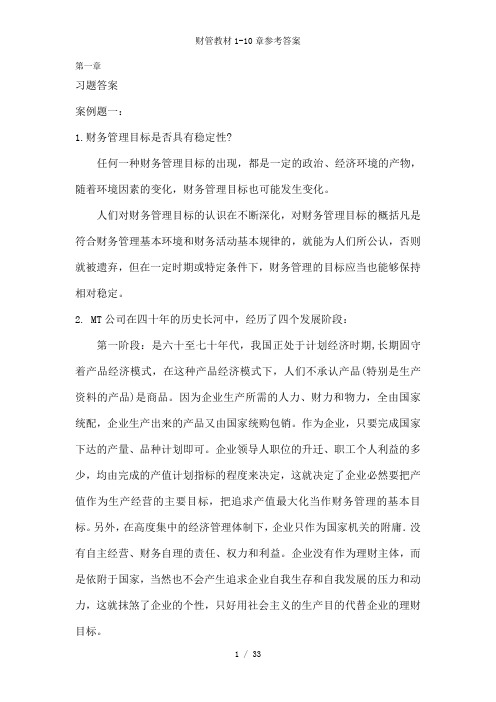
第一章习题答案案例题一:1.财务管理目标是否具有稳定性?任何一种财务管理目标的出现,都是一定的政治、经济环境的产物,随着环境因素的变化,财务管理目标也可能发生变化。
人们对财务管理目标的认识在不断深化,对财务管理目标的概括凡是符合财务管理基本环境和财务活动基本规律的,就能为人们所公认,否则就被遗弃,但在一定时期或特定条件下,财务管理的目标应当也能够保持相对稳定。
2. MT公司在四十年的历史长河中,经历了四个发展阶段:第一阶段:是六十至七十年代,我国正处于计划经济时期,长期固守着产品经济模式,在这种产品经济模式下,人们不承认产品(特别是生产资料的产品)是商品。
因为企业生产所需的人力、财力和物力,全由国家统配,企业生产出来的产品又由国家统购包销。
作为企业,只要完成国家下达的产量、品种计划即可。
企业领导人职位的升迁、职工个人利益的多少,均由完成的产值计划指标的程度来决定,这就决定了企业必然要把产值作为生产经营的主要目标,把追求产值最大化当作财务管理的基本目标。
另外,在高度集中的经济管理体制下,企业只作为国家机关的附庸.没有自主经营、财务自理的责任、权力和利益。
企业没有作为理财主体,而是依附于国家,当然也不会产生追求企业自我生存和自我发展的压力和动力,这就抹煞了企业的个性,只好用社会主义的生产目的代替企业的理财目标。
在传统的集权管理模式下,人们普遍把企业的理财目标及社会主义生产目的看作一回事,认为企业的理财目标就是为了满足整个社会日益增长的物质文化生活需要。
这种传统观点的结果,只能导致理论及实际相脱离。
社会物质文化生活的需要,是对商品使用价值的需要,它最终体现在一定数量,质量和品种的商品或劳务上,尽管它们及商品的价值有着密切联系,但使用价值的本身毕竟不就是价值,财务管理的一个最本质的特点,在于它是以价值形式(货币角度)进行的管理,显然价值的管理及使用价值的管理,不论在影响因素,管理要求,还是方法手段上都各不相同。
《财务管理学》(人大版)第十章习题答案

第10章短期筹资管理一、名词解释1、短期筹资2、信用借款3、循环协议借款4、票据贴现5、商业信用6、信用额度7、担保借款8、应用账款余额百分比9、质押借款 10、短期融资券二、判断题1.信用额度是指商业银行和企业之间商定的在未来一段时间内银行必须向企业提供的无担保贷款()2.循环协议借款是一种特殊的信用额度借款、企业和银行要协商确定贷款的最高限额,在最高限额内,企业可以借款、还款,再借款、再还款,不停地周转使用。
()3.信用额度借款和循环协议借款的有效期一般为1年。
()4. 循环协议贷款不具有法律约束力,不构成银行必须给企业提供贷款的法律责任,而信用额度贷款具有法律约束力,银行要承担额度内的贷款义务。
()5. 企业采用循环协议借款,除支付利息外,还要支付协议费,而在信用额度借款的情况下,一般无须支付协议费。
( )6. 质押借款是指按《中华人民共和国担保法》规定的质押方式,以借款人或第三人的不动产或权利作为质押物而取得。
()7. 票据贴现是银行信用发展的产物,实为一种商业信用。
()8.贴现率是指贴现息与贴现金额的比率。
()9. 商业信用是指商品交易中的延期付款或延期交货所形成的借贷关系,是企业之间的一种直接信用关系。
()10. 赊购商品和预付货款是商业信用融资的两种典型形式。
()11. 商业信用筹资的优点是使用方便、成本低、限制少、缺点是时间短。
()12.应付费用所筹集的资金不用支付任何代价,是一项免费的短期资金来源,因此可以无限制地加以利用。
()13. 银行短期借款的优点是具有较好的弹性,缺点是资金成本较高,限制较多。
()14. 由于丧失现金折扣的机会成本很高,所以购买单位应该尽量争取获得此项折扣。
()15. 利用商业信用融资的限制较多,而利用银行信用融资的限制较少。
()16.直接销售的融资券是指发行人直接销售给最终投资者的融资券。
()17. 金融企业的融资券一般都采用间接发行形式。
()18. 目前我国短期融资券的利率一般要比银行借款利率高,这是因为短期融资券的成本比较高。
财务管理第十章
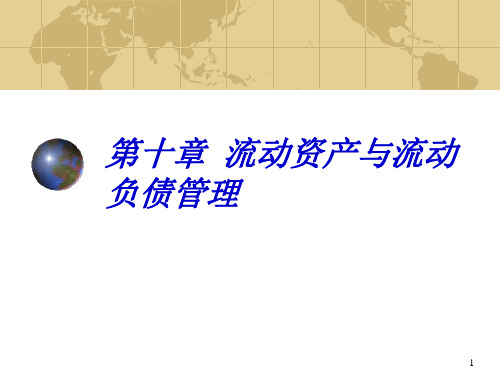
41
(二)企业的信用评估
1、5C评估法:指重点分析影响企业信用的 五个方面的一种方法。 (1)品德 (character) (2)能力 (capacity) (3)资本 (capital) (4)抵押品 (collateral) (5)情况 (conditions)
42
2、信用评分法:现对一系列财务比率和信 用情况指标进行评分,然后进行加权平均,得 出顾客综合的信用得分,并以此进行信用评估 的一种方法。 (三)收账的日常管理 1、确定合理的收账程序
3
第十章 流动资产管理
教学要点 教学内容 思考题 自测题 自测题答案 习题 案例分析 参考文献
4
教学要点
熟悉现金日常管理的内容和方法;
应收帐款日常管理的内容; 掌握企业持有现金的动机; 掌握应收帐款的功能与成本; 存货的经济批量和ABC控制法;
《贷款通则》对短期借款的分类;
商业信用的形式及条件; 短期融资券筹资的优缺点。
第十章 流动资产与流动 负债管理
1
《财务管理》课程结构
总 论 第1章
财务管理的基础观念 第2章
财务(报表)分析工具 第3章
财务管理基本内容
筹资 第4 、5 、6 章
投资 第7 、8 章
营运资金管理 第9、10章
利润及其分配 第11章
2
教学内容
第一节 第二节 第三节 现金管理 应收帐款管理 存货管理
2、坏账成本:应收账款因故不能收回而给应收 账款持有企业带来的损失,就是坏账成本。一 般与应收账款发生的数量成正比。
26
3、管理成本:是指企业对应收账款
进行管理而耗费的开支,是应收账款 的重要组成部分。
(1)调查顾客信用情况的费用; (2)收集各种信息的费用; (3)帐簿的记录费用; (4)收账费用; (5)其他费用。
- 1、下载文档前请自行甄别文档内容的完整性,平台不提供额外的编辑、内容补充、找答案等附加服务。
- 2、"仅部分预览"的文档,不可在线预览部分如存在完整性等问题,可反馈申请退款(可完整预览的文档不适用该条件!)。
- 3、如文档侵犯您的权益,请联系客服反馈,我们会尽快为您处理(人工客服工作时间:9:00-18:30)。
第10章练习答案
1.万泉公司最近从宝达公司购进原材料一批,合同规定的信用条件是“2/10,n/40”。
如果万泉公司由于流动资金紧张,不准备取得现金折扣,在第40天按时付款。
试计算这笔资金的资金成本。
解:资金成本=2% /(1-2%)×360/30 = 24.49%
2.某企业采购商品的信用条件为“4/10,1/35,n/40”,若放弃第一次现金折扣机会而在第35天付款,其机会成本为多少?若两次折扣机会均放弃而在第40天付款,其机会成本又为多少?
解:放弃第一次折扣的机会成本=(4%-1%)/(1-4%)×360/(35-10)= 45% 放弃第二次折扣的机会成本=1% /(1-1%)×360 /(40-35)= 72.73%
3.某公司拟采购一批商品,供应商报价如下:
(1)立即付款,价格为9630元;
(2)30天内付款,价格为9750元;
(3)31天至60天内付款,价格为9870元;
(4)61天至90天内付款,价格为10000元。
假设银行短期借款利率为5%,每年按360天计算。
要求:计算放弃现金折扣的成本,并确定对该公司最有利的报价方案。
解:(1)立即付款
折扣率=(10000-9630)/10000=3.70%
放弃折扣的成本=3.70%÷(1-3.70%)×360/(90-0)=15.37% (2)30天内付款
折扣率=(10000-9750)/10000=2.50%
放弃折扣的成本=2.50%÷(1-2.50%)×360/(90-30)=15.38% (3)60天内付款
折扣率=(10000-9870)/10000=1.30%
放弃折扣的成本=1.30%÷(1-1.30%)×360/(90-60)=15.81% (4)90天内付款
折扣率=0
放弃折扣的成本=0
可见,对公司最有利的应是第三种报价方案。
